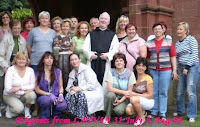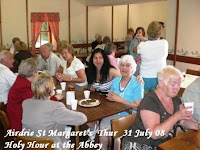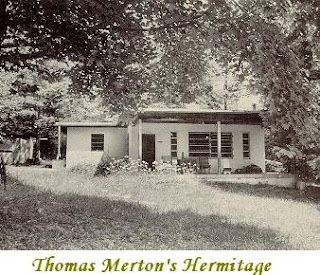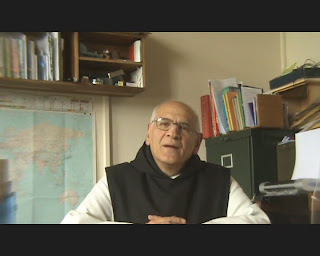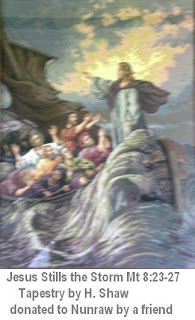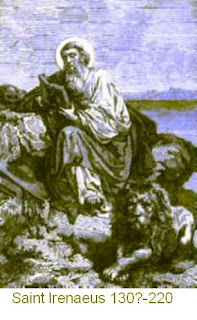 Best Seller in the Making
Best Seller in the Making
Cyril of Alexander and Irenaeus of Lyons.
It just so happens that these two major early Fathers of the Church
are celebrated on the consecutive dates June 27th and 28th.
What makes it interesting is that they will both be part of the ‘best seller in the making’ of Benedict XVI.
From the year 2006, the Holy Father has been using his weekly Wednesday Audiences to give a substantial sketch of the Apostles, fathers and Doctors of the Church.
Cases in point are the feasts of Irenaeus and Cyril of Alexandria, the one a voice of gentle clarity in the Gnostic polemics, the other a fiery controversialist with the Nestorians.
Ironically Irenaeus, the friend of Pope and of dissidents, living up to his name of PEACE and reconciliation, in a later century, 1562, having his shrine in Lyons destroyed by Calvinists.
Cyril, much later, and noted for his more robust or aggressive attitudes receives the most scathing comment on his achievements, that  IF he had been more patient and diplomatic Nestorianism might not have arisen or continued so long.
IF he had been more patient and diplomatic Nestorianism might not have arisen or continued so long.
Their lives make an interesting contrast and Pope Benedict XVI personal insight into Church of the Fathers will make it all the more enthralling and instructive.
In his Audiences the Pope is explaining to the faithful not so much the “what” of the Church, but the “who,” beginning with those who guided it during the first centuries, building up the great Tradition from which the Church of today draws. He highlights each time not only the originality but also the perennial relevance of the work of each Father of the Church.
Here is what the Pope has systematically presented to date:
In the manner of prolegomena
Christ and the Church
The Apostles, Witnesses of Christ’
The Gift of "Communion"
Safeguarding the Gift of Communion
Communion in Time: Tradition
The Apostolic Tradition of the Church
The Apostolic Succession
The Apostles
The Sub-Apostolic continuation
Fathers of the Church
Papal Audiences, Wednesday 2006-2008
See Vatican Website
2006
3 May 2006, The Apostolic Tradition of the Church
17 May 2006, Peter, the fisherman
24 May 2006, Peter, the Apostle
7 June 2006, Peter, the rock
14 June 2006, Andrew, the "Protoclete"
21 June 2006, James, the Greater
28 June 2006, James, the Lesser
5 July 2006, John, son of Zebedee
9 August 2006, John, the theologian
23 August 2006, John, "the Seer of Patmos"
30 August 2006, Matthew, the tax collector
6 September 2006, Philip, the Apostle
27 September 2006, Thomas, "the twin"
4 October 2006, Bartholomew
11 October 2006, Simon and Jude
18 October 2006, Judas and Matthias
25 October 2006, Paul the Apostle
8 November 2006, St Paul's new outlook
15 November 2006, St Paul and the Spirit
22 November 2006, St Paul and the Church
13 December 2006, Timothy and Titus
2007
10 January 2007, Stephen, the Protomartyr
31 January 2007, Barnabas, Silas (also called Silvanus), and Apollos
7 February 2007, Priscilla and Aquila
14 February 2007, Women at the service of the Gospel
7 March 2007, Saint Clement, Bishop of Rome
14 March 2007, Saint Ignatius of Antioch
21 March 2007, Saint Justin, Philosopher and Martyr
28 March 2007, Saint Irenaeus of Lyons
18 April 2007, Clement of Alexandria
25 April 2007, Origen of Alexandria (1)
2 May 2007, Origen of Alexandria (2)
30 May 2007, Tertullian
6 June 2007, Saint Cyprian
13 June 2007, Eusebius of Caesarea
20 June 2007, Saint Athanasius of Alexandria
27 June 2007, Saint Cyril of Jerusalem
4 July 2007, Saint Basil (1)
1st August 2007, Saint Basil (2)
8 August 2007, Saint Gregory Nazianzus (1)
22 August 2007, Saint Gregory Nazianzus (2)
29 August 2007, Saint Gregory of Nyssa (1)
5 September 2007, Saint Gregory of Nyssa (2)
19 September 2007, Saint John Chrysostom (1)
26 September 2007, Saint John Chrysostom (2)
3 October 2007, Saint Cyril of Alexandria
10 October 2007, Saint Hilary of Poitiers
17 October 2007, Saint Eusebius of Vercelli
24 October 2007, Saint Ambrose of Milan
31 October 2007, Saint Maximus of Turin
7 November 2007, Saint Jerome (1)
14 November 2007, Saint Jerome (2)
21 November 2007, Aphraates, "the Sage"
28 November 2007, Saint Ephrem
5 December 2007, Saint Chromatius of Aquileia
12 December 2007, Saint Paulinus, Bishop of Nola
2008
9 January 2008, Saint Augustine of Hippo (1)
16 January 2008, Saint Augustine of Hippo (2)
30 January 2008, Saint Augustine of Hippo (3)
20 February 2008, Saint Augustine of Hippo (4)
27 February 2008, Saint Augustine of Hippo (5)
5 March 2008, Saint Leo the Great
12 March 2008, Boethius and Cassiodorus
26 March 2008, Octave of Easter
9 April 2008, Saint Benedict
14 May 2008, Pseudo-Dionysius the Areopagite
21 May 2008, Saint Romanus the Melodist
28 May 2008, Saint Gregory the Great (1)
4 June 2008, Saint Gregory the Great (2)
11 June 2008, Saint Columban
18 June 2008, Saint Isidore of Seville
25 June 2008, Saint Maximus the Confessor
- - - - - - - - - - - - -
Man Fully Alive is the Glory of God
St. Irenaeus
The glory of God gives life; those who see God receive life. For this reason God, who cannot be grasped, comprehended or seen, allows himself to be seen, comprehended and grasped by men, that he may give life to those who see and receive him. It is impossible to live without life, and the actualization of life comes from participation in God, while participation in God is to see God and enjoy his goodness.
The Word became the steward of the Father’s grace for the advantage of men, for whose benefit he made such wonderful arrangements. He revealed God to men and presented men to God. He safeguarded the invisibility of the Father to prevent man from treating God with contempt and to set before him a constant goal toward which to make progress. On the other hand, he revealed God to men and made him visible in many ways to prevent man from being totally separated from God and so cease to be. Life in man is the glory of God; the life of man is the vision of God. If the revelation of God through creation gives life to all who live upon the earth, much more does the manifestation of the Father through the Word give life to those who see God.
CYRIL OF ALEXANDRIA.
The following quote is from the New Catholic Encyclopedia and it expresses Cyril's theme.
"Only if it is the one and the same Christ who is consubstantial with the Father and with men can He save us for the meeting ground between God and man is the flesh of Christ. Only if this is God's own flesh can man come into contact with Christ's divinity through his humanity. Because of our kinship with the Word made flesh we are sons of God. The Eucharist consummates our kinship with the word, our communion with the Father, our sharing in the divine nature-there is very real contact between our body and that of the Word."
More than himself, God could not give. Less than himself, he would not give. We can state that God could not give any less. God gives each person the necessary time to find the Deity and that can be for some a lifetime while for others it is everyday. Merely to receive the Eucharist, but once, is an invaluable and precious gift, but God calls some to a greater good daily. But, to whom much is given, much shall be required.

Above, Pope Benedict XVI’s view of Cyril of Alexandria is that of the very clear cut DOCTOR of the Church. The sculpture of Cyril in the Basilica of Prague portrays, in violent contrast, a very different aspect. A description from ‘catholic.com’ does not mince words on the redoubtable over forceful ecclesiastic. The description expresses it rather humorously. See opposite
“One of four Roccoco statues c. 1760 by Frantisek Ingac Platzer of the eastern Church Fathers that stand in front of the four supporting pillars of the dome .
This sculpture is St. Cyril of Alexandria engaged in some rather unsaintly gloating while he pokes Nestorius of Constantinople with a big stick. Personally I think St. Cyril is rather a disagreeable saint; as patriarch of Alexandria he drove the Jews from the city and attacked various groups that disagreed with him. He disagreed with Nestorius over the status of Mary as the Mother of God and managed to persuade the pope to condemn Nestorius allowing Cyril to depose him.
He is considered to be a top drawer theologian, writing many highly regarded treatises. Quite a number of these were clarifications on the doctrine of the trinity ensuring that Nestorianism would never gain credence in Christian tradition. Cyril and Nestorius really didn't get on.”
+ + + + + + + + + + + +
 If we compare Mary’s title as Mother of God with the privilege of her bodily Assumption into heaven then it is obvious that it is a greater thing to be Mother of God than to be bodily assumed into heaven. There can be no comparison. To be Mother of the Word incarnate is, in an absolute way, greater than any of the other graces with which Mary was favoured. All her other privileges were either a preparation for this or a consequence of this.
If we compare Mary’s title as Mother of God with the privilege of her bodily Assumption into heaven then it is obvious that it is a greater thing to be Mother of God than to be bodily assumed into heaven. There can be no comparison. To be Mother of the Word incarnate is, in an absolute way, greater than any of the other graces with which Mary was favoured. All her other privileges were either a preparation for this or a consequence of this.













